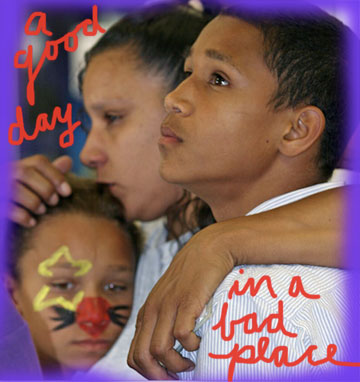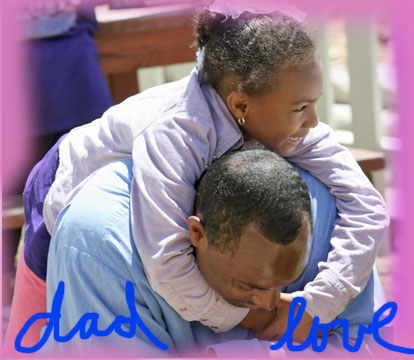In 1999, Sister Suzanne Jabro took a small delegation of women to Vally State Prison at Chowchilla with the idea of starting some kind of program to help the female inmates. At any given time, Chowchilla holds around 8,000 prisoners, making it the largest woman’s incarceration facility in the world. Sister Suzanne, and her colleagues from non-profit Women and Criminal Justice (now the Center for Restorative Justice Works), had gotten permission from Chowchilla’s administrators to meet with a group of 60 women. The idea was to ask the inmates themselves what they most wanted or needed when it came to programs.
At the beginning of the meeting, the women were shy and restless and seemed not to know what to say. Finally, however, a first woman spoke.
“We never get to see our kids,” she said simply. Then another woman spoke up. “I can’t live without my kids,” she said, and she began to cry. The meeting exploded with voices. It seemed the women were not interested in amenities or privileges. Seeing their kids. That was the thing.
Within minutes, the meeting, the room was awash with outpourings of grief and longing about children. “By the end, nearly every woman in the room was sobbing,” said Sister Suzanne when we spoke this week. “Not crying. Sobbing.”
Was there any way that Jabro and her group could make seeing their kids possible? the women wanted to know.
Sister Suzanne assured the inmate women she would see what she could do. And “Get On the Bus” was born—a program that brings the children of incarcerated women to prison see their moms on Mother’s Day.
This Sunday, Get On the Bus will bring 1200 kids together with their mothers. On Father’s Day they will bring several hundred to visit their dads. Getting the right paperwork and permissions is a logistical nightmare, but every year the number of kids and the number of program sponsors expands. “Now we get calls from other states and Canada asking how they can start their own Get On The Bus,” Suzanne said.
You’d the think the need and the benefit would be obvious, and that it would have been done long ago, she said. “But it wasn’t.”
Still, as successful as the program has been, it is a small drop in a very large bucket. 200,000 California kids have one or more parents in prison. Get On the Bus serves less than 1 percent of those kids.
I first learned of the program from the California Department of Corrections, which now happily touts its partnership in the Get On the Bus efforts.
It was not always thus. The first year of the program, Sister Suzanne and company nearly didn’t get any kids in at all. “The prison officials were really against it,” she said. “They worried about security, of course. But mostly, they said, they didn’t feel that the mothers deserved to see their children.”
Sister Suzanne, who has spent much of the last 30 years working in some kind of detention ministry and/or “restorative justice,” pleaded with the prison higher ups. “I told them it wasn’t about the mothers, it was about the kids. The kids needed it.”
Finally the CDCR relented. They would try it one time. Get on the Bus was allowed to bring in nine families for a total of 17 kids, all of whom had not seen their mothers in a very, very long time.
Most of the children were living with grandmothers or other relatives who had neither the time nor money to go carting kids around to prisons for visits. Other kinds of contact was sporadic too. Collect phone calls were, of course, hideously expensive.
Out of all the studies that have been done on prison populations, comparatively few have been done on the affect of incarceration on the children of those locked up. But the research that has been done indicates a great degree of harm. Kids do less well in school, have more emotional problems, are more likely to get in trouble, teenage girls are more likely to get pregnant. Conversely, the more there is able to be positive contact with the locked-up parent, the fewer problems the kid is statistically likely to have.
Studies of prisoners have long indicated that those able to maintain close family relationships—particularly with their children— are more likely to do well outside when they are paroled. (And most of those in our prisons, state and federal both, will eventually be paroled.) “Children give men and women someone to do well for,” said Sister Suzanne. “You’d think that’d be a no-brainer. But, in terms of policy, it doesn’t seem to be.”
As I said, Sunday’s 1200 kids who will be boarding Sister Suzanne’s buses are just a fraction of the children and parents who could benefit from such visits.
But it’s a start.
And, by the way,” says Suzanne Jabro, “most of the kids we serve come from Los Angeles.”



Sounds like a worthwhile program. Hope all moms have a happy Mother’s Day.
I think so too, Sure Fire. It made me happy to put this story up.
Most believe that God designed the family as the basic unit of our society, while many families are dysfunctional; the majority of families offer substantial support to prisoners during incarceration and when they are released.
A functioning family helps him or her take the first steps from prison to freedom. Family members are the most likely and the most reliable help for returning prisoners.
However the state prison systems seem designed to break the family bonds.
– Most inmates are imprisoned hundreds of miles from their families.
– Many prisons prohibit relatives other than then parent from bringing their children to visit their parent. No grandparents, aunts or brothers are allowed to bring them.
– Many Prisons prohibit children from visiting unless the incarcerated parent is listed on their birth certificate.
– Many inmates lose parental rights permanently, because inmates often receive no notice of hearings and have no representation.
– Many Prisons have no visiting hours in the evenings or on weekends, eliminating visits for working spouses and parents.
– Prisons charge as much as $3.95 to place the call plus $0.89 per minute.
– Many Prisons prohibit religious volunteers who work with inmates inside prison from having any contact with the inmate after release.
– Many prisons remove the new born baby from the mother right after childbirth.
What a great program! I visited their site and will send a little “help”. Speaking from experience, there’s nothing like contact with family, friends from the street to instill some hope and positive focus in an inmate. I see also that the good Sister is a member of the Order of St. Joseph. Catholics have taken plenty of flak lately. It’s refreshing to see a little of the good works the church and its people can put forth.
Sadly far too many of our citizens are being incarcerated for non-violet non serious crimes, some for life under California’s draconian Three Strikes Law. A law that was sold to the public with ads produced and paid for by the prison guards union that has a vested interest in keeping our prison full. Many men and women are returned to prison for technical parole violations by parole officers that are also members of the same union. Something is drastically wrong with a system operates in such a manner. To save money the legislature has slashed visiting, rehabilitation, education programs and substance abuse programs. Such short sighted decisions have only made it worse for the inmates and their families. 95 % of all inmates are coming home eventually. How we treat them and their families should be a concern of everyone. Why do we allow such a broken system to operate? Do prisons really make us safer?